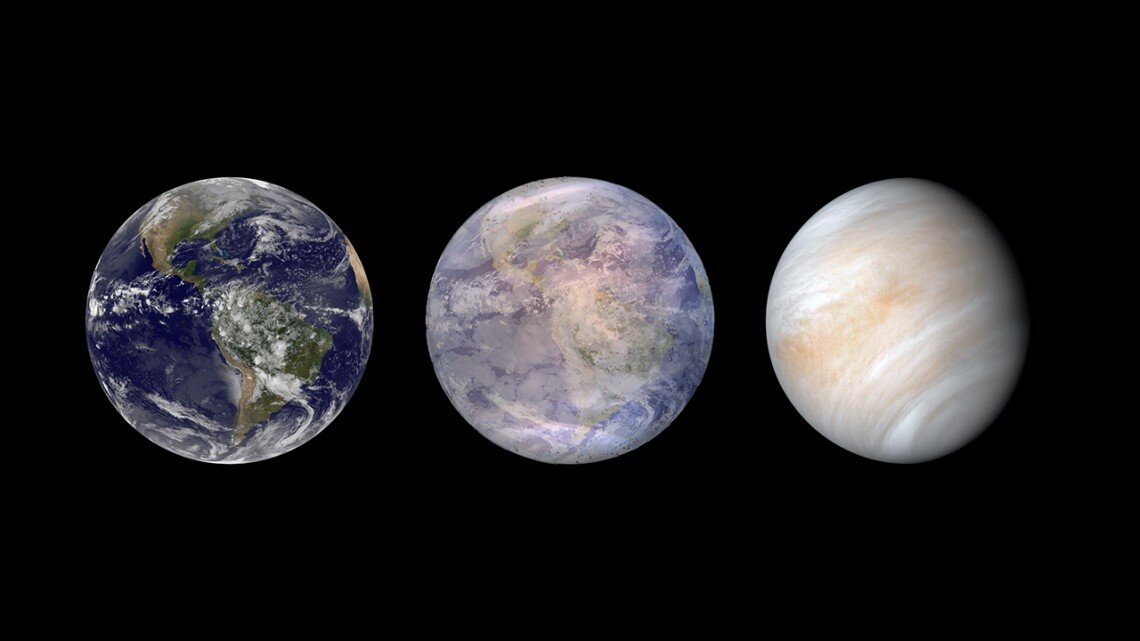In exoplanetology, the ring around the star is often called the “Goldilocks zone,” in reference to the 19th-century fairy tale Goldilocks and the Three Bears. In that story, Goldilocks encounters sets of three objects that are either too extreme for her liking or just right. In the case of a bowl of porridge, the three are too hot, too cold, and just right, hence the analogy to an exoplanet’s position around its star. If it’s too close to its parent star, the planet is too hot, and liquid water, the necessary ingredient for life, won’t exist. If it’s too far, the planet is too cold, and the only water on its surface will be ice. But even the “just right” category has some wiggle room. Many planetary scientists consider Venus to be on the inner edge of our star’s “just right” habitable zone. So why did it end up with such a different fate than our pale blue dot? A team of researchers, led by Lisa Kaltenegger at Cornell, think they have found a way to answer that question – by turning the world’s most powerful space telescope towards a star about 100 light years away and directly observing an exoplanet’s atmosphere.
The planet, LP 890-c, was first cataloged in September of 2022 as part of a survey by the Search for habitable Planets EClipsing ULtra-cOOl Stars – or SPECULOOS because astronomers can’t resist an acronym no matter how contrived. It orbits the second coolest star of all known exoplanets, which the planet orbits in about 8.5 days. Weighing in at about 40% more than Earth’s mass, it is considered a “Super-Earth” in the standard terminology of exoplanetology.
It also resides just inside the innermost boundary of its star’s Goldilocks zone. That means it could potentially harbor liquid water, either on its surface or in its atmosphere. And it has another advantage – its star is only 100 light years away from Earth.
That is relatively close, at least in astronomical terms. And the planet is large enough that its atmosphere could theoretically be directly imaged by the world’s most powerful space telescope – the James Webb Space Telescope (JWST). One of JWST’s primary mission goals is just that – directly imaging exoplanet atmospheres, so it’s safe to say that the mission team is on the hunt for potential exoplanets that could prove exciting targets.
Most astronomers agree that the most exciting target system is TRAPPIST-1, which has so many interesting planets orbiting it that we’ve written multiple articles on that system alone. But LP 890-c comes in a close second. In part, that is because a better understanding of its atmosphere could help determine why Venus, in a similarly spaced orbit around our own star, ended up so different from Earth.
The comparison isn’t exact – Venus takes 225 days to spin around the sun, while LP 890-c takes only 8.5. But that in itself is an advantage, as the method JWST will use to image its atmosphere, transiting, requires the planet to pass in front of its parent star. Its orbital period alone decreases the necessary observing time to something more reasonable than trying to capture the image of a replica of Venus around a Sun-like star.
Given those differences, the researchers, led by Jonathan Gomez Barrientos, a graduate student at Cal Tech, wrote a second paper where they did some modeling to determine what exactly JWST would be expected to see given a few different atmospheric compositions on the planet. One of the most important parts of that model is how much of JWST’s precious observational time it would take to understand LP 890-c’s atmosphere.
The paper determined there were three different possible observational times. One, which would last for only three transits (25.5 days), could determine whether the planet even has an atmosphere at all. Another, lasting eight transits (68 days), could determine whether its atmosphere is similar to Venus’. An even longer observational window of 20 transits (170 days) would be necessary to find a potentially habitable atmosphere.
That is admittedly a long time on the world’s most powerful space telescope. But it’s not entirely out of the question. For now, these papers are laying the scientific groundwork for observational time, and the researchers will have to go through the same observing time request process as others in the field. But given the potential for impact of this study, there’s a good chance that we might begin to see details of LP 890-c’s atmosphere shortly.
Learn More:
Cornell – Exoplanet may reveal secrets about the edge of habitability
Kaltenegger et al – Hot Earth or Young Venus? A nearby transiting rocky planet mystery
Barrientos et al. – A Venus in the making? Predictions for JWST observations of the ultracool M-dwarf planet LP 890-9 c
UT – Finally, JWST’s Data on the First TRAPPIST-1 Planet. Survey Says? It Sucks
Lead Image:
Artist’s impression of a transitionary planet between Earth (left) and Venus (right).
Credit – Carl Saga Institute / R. Payne

